

Cryobots Could Drill Into Icy Moons With Remote Fiber-Optic Laser Power. Future extraterrestrial rovers may be powered remotely by high-energy laser beams shot through miles of thin fiber-optic cables.
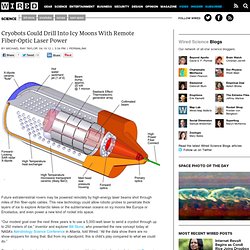
The NSA Is Building the Country's Biggest Spy Center (Watch What You Say) Photo: Name Withheld; Digital Manipulation: Jesse Lenz.
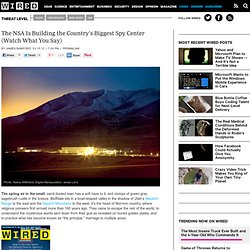
Are you ready for a 'quantified life'? Opinion April 14, 2012 07:00 AM ET Computerworld - That smartphone you carry around is a box full of sensors.
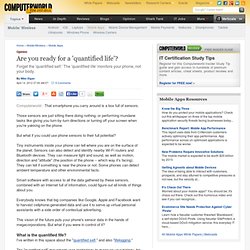
Those sensors are just sitting there doing nothing, or performing mundane tasks like giving you turn-by-turn directions or turning off your screen when you're yakking on the phone. But what if you could use phone sensors to their full potential? Tiny instruments inside your phone can tell where you are on the surface of the planet. Physicists Create First Long-Distance Quantum Link. By Jim Heirbaut, ScienceNOW For more than a decade, physicists have been developing quantum mechanical methods to pass secret messages without fear that they could be intercepted.
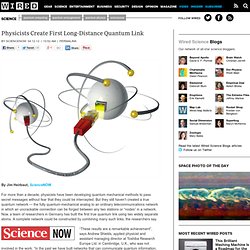
But they still haven’t created a true quantum network — the fully quantum-mechanical analog to an ordinary telecommunications network in which an uncrackable connection can be forged between any two stations or “nodes” in a network. Now, a team of researchers in Germany has built the first true quantum link using two widely separate atoms. A complete network could be constructed by combining many such links, the researchers say. Above the Fold & Socially Acceptable. User experience optimization is just as important as any other SEO practice Being the amazing search engine marketer that you are, every single page of your website has been perfectly optimized.
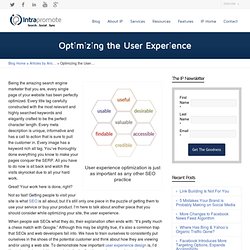
Every title tag carefully constructed with the most relevant and highly searched keywords and elegantly crafted to be the perfect character length. Every meta description is unique, informative and has a call to action that is sure to pull the customer in. Every image has a keyword rich alt tag. You’ve thoroughly done everything you know to make your pages conquer the SERP. Great! Not so fast! Nasa. For those of you waiting to see the results from our on-orbit checkout of the smartphone, this post summarizes our data.
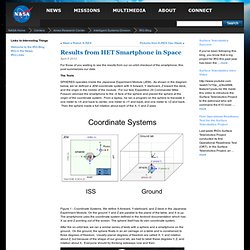
The Tests SPHERES operates inside the Japanese Experiment Module (JEM). Nokia Lumia 900 review. Long-awaited, heralded, longed for, lusted after, overdue, deal breaker, savior, second coming, dead-on arrival, revelation, last gasp, comeback, hail mary pass, flagship... finally!
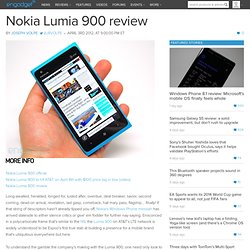
If that string of descriptors hasn't already tipped you off, Nokia's Windows Phone messiah has arrived stateside to either silence critics or give' em fodder for further nay-saying. Ensconced in a polycarbonate frame that's similar to the N9, the Lumia 900 on AT&T's LTE network is widely understood to be Espoo's first true stab at building a presence for a mobile brand that's ubiquitous everywhere but here. To understand the gamble the company's making with the Lumia 900, one need only look to another critically acclaimed, yet interminably stalled overseas import: Kylie Minogue. That foreign pop siren, a music industry veteran, has repeatedly failed to empty mainstream American wallets with her scattered hits, despite enjoying chart domination across the globe.
Nokia Lumia 900 review See all photos 100 Photos. Exclusive: a behind-the-scenes look at Facebook release engineering. Google Gets Transparent With Glass, Its Augmented Reality Project. Larry Page and Sergey Brin have long had the dream of a hands-free, mobile Google, where search was a seamless process as you moved around the world.
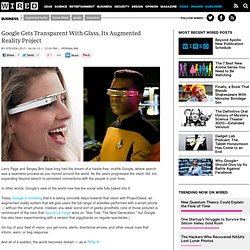
As the years progressed the vision did, too, expanding beyond search to persistent connections with the people in your lives. In other words, Google’s view of the world now has the social side fully baked into it. Today, Google is revealing that it is taking concrete steps towards that vision with ProjectGlass, an augmented reality system that will give users the full range of activities performed with a smart phone — without the smart phone. The Pretense of Knowledge - Friedrich A. Hayek. [Lecture to the memory of Alfred Nobel, December 11, 1974] The particular occasion of this lecture, combined with the chief practical problem which economists have to face today, have made the choice of its topic almost inevitable.
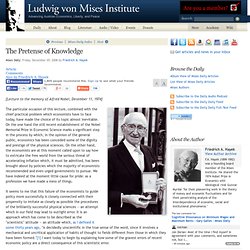
On the one hand the still recent establishment of the Nobel Memorial Prize in Economic Science marks a significant step in the process by which, in the opinion of the general public, economics has been conceded some of the dignity and prestige of the physical sciences. Human brain has been 'shrinking for the last 20,000 years' By Daily Mail Reporter Updated: 18:05 GMT, 31 December 2010 It's not something we'd like to admit, but it seems the human race may actually be becoming increasingly dumb.
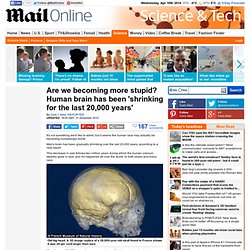
Man's brain has been gradually shrinking over the last 20,000 years, according to a new report. This decrease in size follows two million years during which the human cranium steadily grew in size, and it's happened all over the world, to both sexes and every race. Old big head: A 3D image replica of a 28,000-year-old skull found in France shows it was 20 per cent larger than ours. Introduction to Microsoft Sync Framework. Microsoft CorporationOctober 2009 Introduction Microsoft Sync Framework is a comprehensive synchronization platform enabling collaboration and offline for applications, services and devices.
Developers can build synchronization ecosystems that integrate any application, any data from any store using any protocol over any network. Sync Framework features technologies and tools that enable roaming, sharing, and taking data offline. A key aspect of Sync Framework is the ability to create custom providers. A number of providers are included by Sync Framework that support many common data sources. Database synchronization providers: Synchronization for ADO.NET-enabled data sourcesFile synchronization provider: Synchronization for files and foldersWeb synchronization components: Synchronization for FeedSync feeds such as RSS and ATOM feeds Developers can ultimately use any of the out-of-the-box providers or can create custom providers to exchange information between devices and applications.
'Mind-reading device' recreates what we see in our heads. Counter Intelligence: 800 Degrees in Westwood. Pininfarina designs Ferraris.